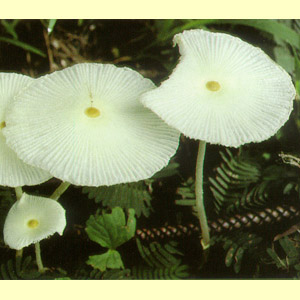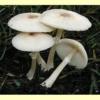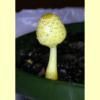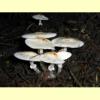




Lepiota minya also appears to belong in Leucocoprinus.
Breitenbach, J. & Kranzlin, F. (eds) (1995), Fungi of Swizerland. Volume 4. Agarics 2nd part. Edition Mykologia, Lucerne. [Description, Illustration and Microcharacters of L. birnbaumii and L. cepistipes from Europe]
Fuhrer, B. (2005), A Field Guide to Australian Fungi. Bloomings Books, Hawthorn. [Description and Illustration of L. birnbaumii]
Grgurinovic, C.A. (1997a), Larger Fungi of South Australia. The Botanic Gardens of Adelaide and State Herbarium and The Flora and Fauna of South Australia Handbooks Committee, Adelaide. [Description and Microcharacters of Lepiota minya]
Imazeki, R., Otani, Y. & Hongo, T. (1988), Fungi of Japan. Yama-Kei Publishers, Tokyo. [Illustration of L. birnbaumii and L. fragilissimus from Japan]
McCann, I.R. (2003), Australian Fungi Illustrated. Macdown Productions, Vermont. [Illustration of Leucocoprinus sp.]
Pegler, D.N. (1977), A preliminary agaric flora of East Africa, Kew Bull., Addit. Ser. 6: 1–615. [Description, B&W Illustration and Microcharacters of L. birnbaumii and L. cretaceus (as L. cepistipes) from East Africa]
Pegler, D.N. (1983c), Agaric flora of the Lesser Antilles, Kew Bull., Addit. Ser. 9: 1–668. [Description, B&W Illustration and Microcharacters of L. birnbaumii, L. cretaceus (as L. cepistipes) and L. fragilissimus, with Illustration of the latter two species, all from the Lesser Antilles]
Vellinga, E. (2001b), Leucocoprinus, in M.E. Noordeloos, T.W. Kuyper & E.C. Vellinga (eds), Flora Agaricina Neerlandica, Volume 5, 76–84. A.A. Balkema Publishers, Lisse. [Description, B&W Illustration and Microcharacters of L. birnbaumii and L. cretaceus along with Key to the eight Dutch species]
Young, A.M. (2005b), A Field Guide to the Fungi of Australia. University of New South Wales Press, Sydney. [Description and Illustration of L. birnbaumii]
